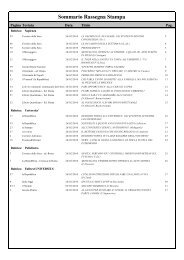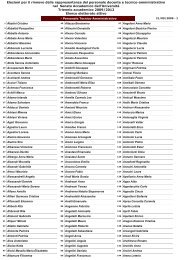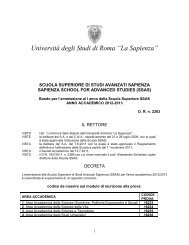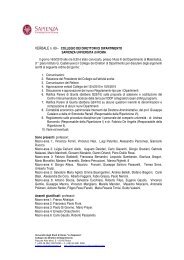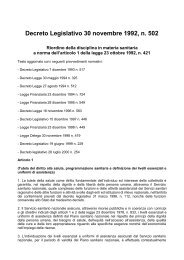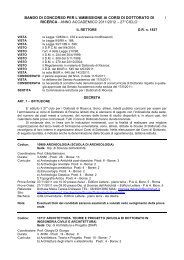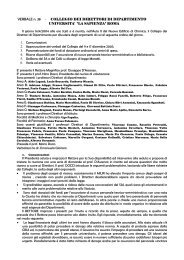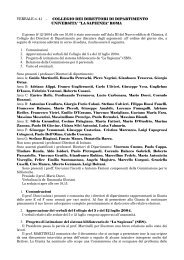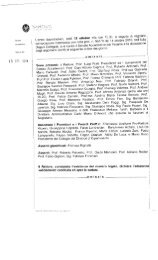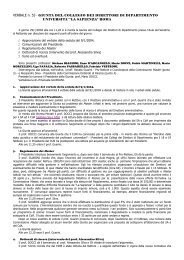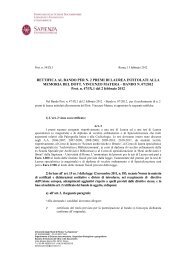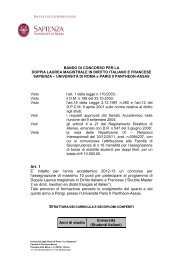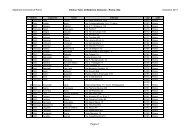HOMO SAPIENS
HOMO SAPIENS
HOMO SAPIENS
Create successful ePaper yourself
Turn your PDF publications into a flip-book with our unique Google optimized e-Paper software.
AN EXCEPTIONAL INTERNATIONAL<br />
EXHIBITION TELLING US WHERE WE<br />
CAME FROM AND HOW WE MANAGED<br />
TO POPULATE THE ENTIRE PLANET<br />
Curated by Luigi Luca Cavalli Sforza and Telmo Pievani<br />
<strong>HOMO</strong><br />
<strong>SAPIENS</strong><br />
THE GREAT HISTORY<br />
OF HUMAN<br />
DIVERSITY<br />
Rome, Palazzo delle Esposizioni<br />
November 11, 2011 | February 12, 2012<br />
Under the High Patronage of the<br />
President of the Italian Republic
THE FIRST EXHIBITION IN THE WORLD THAT<br />
TELLS THE STORY OF MANKIND THROUGH A<br />
LARGE MULTIDISCIPLINARY FRESCO:<br />
AN INTERNATIONAL PROJECT INVOLVING<br />
MORE THAN 50 MUSEUMS, UNIVERSITIES AND<br />
LIBRARIES FROM 9 DIFFERENT COUNTRIES<br />
<strong>HOMO</strong><br />
<strong>SAPIENS</strong><br />
THE GREAT HISTORY<br />
OF HUMAN<br />
DIVERSITY<br />
Rome, Palazzo delle Esposizioni<br />
November 11, 2011 | February 12, 2012<br />
Venice, Venetian Institute of Arts and Sciences,<br />
March | June 2012<br />
Trento, Tridentine Museum of Natural Sciences,<br />
October | December 2012
EACH VILLAGE IS A MICROCOSM<br />
THAT TENDS TO REPRODUCE<br />
THE MACROCOSM OF ALL MANKIND,<br />
ALBEIT A BIT DIFFERENT<br />
IN PROPORTIONS<br />
LUIGI LUCA CAVALLI SFORZA<br />
Map of H.Sapiens migration through time based on genetic data analisys<br />
Homo Sapiens. The great history of human diversity is an international exhibition,<br />
conceived entirely in Italy, dedicated to the ambitious interdisciplinary<br />
research project founded, among others, by the Italian geneticist, professor<br />
emeritus at Stanford University, Luigi Luca Cavalli Sforza, who for decades<br />
has probed the most hidden recesses of the depths of the history of human<br />
diversity, uniting molecules, fossils, cultures and languages in a coherent<br />
overall framework of evidence.<br />
Today for the first time, an international group of scientists has begun to connect<br />
the paths of ancient history that led our species to leave a small valley in<br />
Ethiopia less than 200,000 years ago to colonize the whole planet, region after<br />
region, spreading to form a wide variety of peoples and different cultures.<br />
This exhibition tells where we came from and how we managed, migration by<br />
migration, to populate the entire planet, constructing a kaleidoscopic mosaic<br />
of current human diversity.<br />
MANY OTHER HISTORIES BEFORE THE “HISTORY”: WE WERE NOT ALONE<br />
What happened in that long and mysterious period of time between the birth<br />
of our genus Homo in Africa and that of the human history written with a<br />
capital ‘H’ that we study in school? Where did the many populations whose<br />
successors are living in every region of the Earth come from? We, as a human<br />
species, have only been on this planet for a very short time.<br />
If an extraterrestrial anthropologist had come down to Earth a few thousand<br />
years before the construction of the Egyptian pyramids, he would have come<br />
across at least five species of the Homo genus: our ancestors of the Homo<br />
sapiens species spread all over the world, along with the robust and intelligent<br />
Neanderthals in Europe and Asia, to perhaps another species of Homo<br />
discovered in 2010 in southern Siberia, to the later form of the species Homo<br />
erectus that survived in the valleys on Java, and the small hobbits (Homo floresiensis)<br />
who lived on the island of Flores in Indonesia: another surprising<br />
and very recent cousin of modern man, discovered in 2004 – small pygmylike<br />
humans with a brain no bigger than a chimpanzee’s, but possessing the<br />
same advanced technology as Homo sapiens.<br />
Yet not long afterward, modern man would remain as the only specimen of<br />
humanity on Earth at the end of a process of diversification of the various<br />
species of the genus Homo that had begun two million years earlier: a process<br />
that had produced the first completely biped exemplars of Homo, such as the<br />
charming little boy of the Turkana, then followed by a series of “out of Africa”<br />
expansions, with sites inhabited by ancient species of the genus Homo in<br />
Georgia, Pakistan, China, Indonesia, Spain and throughout the “old world”.<br />
We descend from a history of walkers and small tribes that expanded their<br />
territories to survive. Not only that, but we are the products of six million<br />
years of hominid diversification, adaptations, innovations and explorations<br />
of different biogeographical areas, of a variety of bipedal forms (two of which<br />
already walked on the volcanic ash at the Laetoli site 3.5 million years ago!)<br />
that inspired the paleoanthropologist Tim White to use the metaphor of the<br />
intergalactic bar, borrowed from Star Wars. In the end, however, after a long<br />
period of prehistoric encounters of different types (perhaps with some hybri-
dization between homo sapiens and native species) and after the emergence<br />
of the cognitively modern sapiens during the “Paleolithic Revolution” which<br />
is not yet fully understood, we were alone. It is difficult to know if our visitor<br />
from outer space would have bet on this outcome or not, but we can’t deny<br />
that our species, being the only one left, has differentiated itself in an unprecedented<br />
variety of groups and cultures. A species that is biologically and<br />
cognitively young, but immensely different in its cultural expressions.<br />
FROM ONE OF THE WORLD’S<br />
MOST IMPORTANT GENETICISTS<br />
A LOOK AT THE HISTORY<br />
OF HUMAN DIVERSITY<br />
TO UNDERSTAND<br />
THE BIOLOGICAL AND<br />
CULTURAL IMPORTANCE<br />
All relatives, all different: despite physical and cultural<br />
differences we all belong to the same race<br />
Reconstruction of “Mitochondrial Eva”, the common ancestor<br />
of all humanity (sketch by L. Possenti)
Flores Woman<br />
Incised bone artefact,<br />
Mesolithic, “Riparo<br />
Gaban”, Italy<br />
EXHIBITION OF A NEW PARADIGM OF<br />
SCIENTIFIC COMMUNICATION<br />
The research behind the exhibition makes it a very innovative and exciting<br />
challenge in the field of science communication: for the first time ever,<br />
researchers around the world belonging to quite different disciplines - such<br />
as genetics, linguistics, anthropology and paleoanthropology - have established<br />
a cooperative project to systematically reconstruct the roots and routes<br />
of human populations. A multidisciplinary and international approach<br />
is reflected both in the contents of the exhibition and in the composition of<br />
the Scientific Committee, for the first time offering the public an overview<br />
of the field research and the results achieved.<br />
THE DISCOVERY OF THE ORIGINS OF MODERN MAN: A SCIENTIFIC<br />
BREAKTHROUGH OF PROFOUND EDUCATIONAL VALUE<br />
Examining the data and comparing the results of the genetic comparisons<br />
applied to the DNA of the present inhabitants of our planet, researchers<br />
were able to outline the great historical-geographical map of migration that<br />
led to the spreading of modern humans worldwide and to discover traces of<br />
expansions, drifting, hybridization and the replacement of populations that<br />
generated the biological and cultural diversity in each region, and probably<br />
once and for all, strengthening the hypothesis of a recent single African origin<br />
of the human species.<br />
The seven billion men and women who populate the entire globe at the<br />
beginning of the 21st century are descended from a small group of several<br />
thousand founders, separated by speciation from an African ancestor less<br />
than 200,000 years ago and who were then able - thanks to their cultural and<br />
technological adaptations - to migrate across the African continent, expand<br />
throughout the Old World, through the Middle East, the coast of the Indian<br />
Ocean and the steppes of the Caucasus, reaching the Far East on the one<br />
hand and Western Europe on the other, only then passing to the “new world”<br />
of the Americas and Australia, never before colonized by humans.<br />
NEW FRONTIERS AND THEIR CONSEQUENCES: A DIFFERENT<br />
PERSPECTIVE ON HUMAN MIGRATION<br />
The history told by the genetics of populations becomes even more fascinating<br />
- especially as told through objects, fossils, artifacts, tools, models,<br />
reconstructions, documents, videos and pictures – when it goes into detail<br />
and speaks to us, for example, of the epic of man in Australia and the Pacific<br />
islands, lands colonized many thousands of years earlier than had been believed,<br />
showing that navigation had already been discovered tens of thousands<br />
of years ago, perhaps in the Mediterranean and certainly in the South Seas by<br />
the ancestors of the Aborigines, who then created a culture that was comple-<br />
tely original in its relationship with the natural environment and the intertwining<br />
of its invisible “Songlines”. Environmental differences between the<br />
islands of the Pacific (in terms of resources, topography, climate and so on)<br />
produced a range of totally different cultures, from urban empires to simple<br />
societies of hunters and gatherers.<br />
The genetics of populations reveals the advance of the first great American<br />
frontier, during which groups of hunter-gatherers from Siberia in the northeast<br />
crossed the lost and icy continent of “Beringia”, now submerged, venturing<br />
down aisles free of ice and bursting onto the endless American prairies<br />
teeming with large mammals, appetizing prey completely unprepared to cope<br />
with this new hunter. It also tells of how five centuries ago other conquistadors<br />
wiped out the descendants of those early natives not only with swords<br />
but also with typhoid and measles. These and other diseases were a result of<br />
the coexistence with the large mammals in Africa and Asia, which the newcomers<br />
were accustomed to, while the Native Americans were not. Thus the<br />
history of human migration also includes the development of various diseases<br />
and immune systems.<br />
A MOSAIC OF DIVERSITY, A MESSAGE OF UNITY<br />
But this planetary history also tells us why some languages, such as Basque,<br />
appear to be different from any other language in the world and why, on the<br />
other hand, some languages as distant from one another as Turkish and Japanese<br />
are offspring of the same mother: strange cases of planetary distribution<br />
and affinities, a large scale process under which the branches of the populations<br />
(and the genetic mutations of which they were carriers) sometimes<br />
coincided with the diversification of families of languages and cultures. As<br />
Darwin had already predicted, the tree of the diversification of the Earth’s population<br />
could allow us to understand the structure of the tree of languages.<br />
The message, once again, is a message of unity - we are a young species<br />
descended from a small group of African forefathers - and of diversity, inasmuch<br />
as from such a small beginning so great a history of innovation and<br />
proliferation of ingenious adaptations has grown.<br />
Homo Sapiens tells us how enemies today, the Arabs and Jews living in<br />
Palestine, are children of the same history. It speaks of the bitter paradox in<br />
which the regions most troubled today by bloody conflicts, such as Afghanistan,<br />
the Caucasus and Iraq, were passageways and originally places of trade<br />
and the most important hybridizations of the human race. They are the true<br />
crossroads of mankind. This exhibition is about human groups who pushed<br />
themselves, perhaps for reasons related to an unquenchable spirit of exploration,<br />
to extreme ramifications around the world, and towards the last areas to<br />
be occupied and inhabited by humans, the Arctic, Iceland and New Zealand,<br />
confirming their ability to adapt to any place.<br />
AN EMOTIONAL, DRAMATIC<br />
AND PROFOUND NARRATIVE.<br />
AN INNOVATIVE AND EXCITING<br />
CHALLENGE IN THE FIELD<br />
OF SCIENCE COMMUNICATION
Sanskrit manuscript, 1630 A.C.<br />
(Courtesy of Dr. Elena Preda, Bologna University)
GUIDED TOURS FOR ALL AGE<br />
GROUPS, EDUCATIONAL WORKSHOPS<br />
AND A CALENDAR OF INTERNATIONAL<br />
MEETINGS AND EVENTS<br />
The exhibition, designed for a wide and heterogeneous audience, offers paths<br />
of reading designed specially to meet the needs of different age targets and<br />
levels of scientific literacy and can be interpreted at different levels of education<br />
and workshops: the evolution of man, our extinct cousins, the movement<br />
of the sapiens species, adaptations to the greatest variety of ecosystems,<br />
genetic and linguistic comparisons, the subject of human races and racism,<br />
the tangle of civilization, the contemporary migrations, the cultural hybridization,<br />
the current biological and cultural diversity …<br />
For these reasons, the exhibition will have a specific educational project - an<br />
interactive and engaging approach based on discovery and shared experiences<br />
- dedicated to the preparation of guides and assistants, in carrying out<br />
educational proposals and internal connections with external institutions and<br />
social networks.<br />
The educational project will be designed for people of different ages, from<br />
children up to age 18 to adults and the elderly. Special attention will ultimately<br />
be devoted to guided tours for schools.<br />
A full calendar of international events will offer the public an opportunity<br />
to deepen and broaden their knowledge of the themes of the exhibition and<br />
participate in topical discussions with personalities from the science, art,<br />
journalism and entertainment worlds.<br />
Reconstruction of “Lagar-Velho child”, hypothesized<br />
Neanderthal-Sapiens hybrid (Portugal). Sketch by L. Possenti
p=8.3%<br />
QE<br />
WCH<br />
Q-ALT1<br />
Q-ALT2<br />
H:318<br />
H:240<br />
CONNETTIVO/ARCHIVIO<br />
2<br />
1<br />
A4<br />
T4<br />
h=4.80<br />
CONNETTIVO<br />
A FASCINATING JOURNEY IN 6 STAGES<br />
ON THE TRAIL OF OUR ANCESTORS<br />
AT THE DAWNING OF THE CONQUEST<br />
OF THE WORLD<br />
h.6.80<br />
6<br />
T4<br />
A9<br />
T4<br />
T4<br />
GALLERIA<br />
T4<br />
T4<br />
5<br />
h=4.80<br />
A8<br />
3<br />
h.6.80<br />
4<br />
T4<br />
CONNETTIVO<br />
T4<br />
T4<br />
p=3%<br />
T4<br />
4<br />
T2<br />
T1<br />
M5-H210<br />
M3-H210<br />
p=5.5%<br />
T2<br />
CONNETTIVO<br />
WCD<br />
T6<br />
T2<br />
T6 T6 T6 T6<br />
WCU<br />
T2<br />
1<br />
2<br />
3<br />
4<br />
5<br />
6<br />
THE PROJECT EXHIBITION: A GREAT HISTORY THAT COMES FROM A<br />
MIX OF EXPRESSIVE LANGUAGES<br />
The exhibition consists of an emotional, dramatic and profound narrative<br />
that is continuous, with an interdisciplinary approach to human evolution<br />
and the history of human diversity. It follows a chronological order of<br />
events and situations, with each section based on a mix of different forms<br />
of expression: the valuable original objects (a fossil, a tool, an artifact, an<br />
ethnographic object) in plaster casts and copies; reconstructions of scenes<br />
and stories, spectacular models of hominids and huge extinct animals,<br />
interactive displays, immersive video and photo installations; geographical<br />
maps, topographic maps, and maps. Environmental lighting and sounds<br />
then complete the installation, enriching it with artistic suggestions.<br />
The captions and explanatory panels will be concise and simple in English<br />
and Italian, with an abundance of graphics that help highlight a reading at<br />
different attention levels. These will often be accompanied by explanatory<br />
texts (quotes, evocative phrases) on the wall spaces, creating a charming<br />
and engaging narrative dimension.<br />
Like the exhibition for the bicentenary of the birth of Charles Darwin,<br />
(www.darwin2009.it) that was highly successful with a total of more than<br />
220,000 visitors, the “Homo Sapiens” exhibition is also aimed at a general<br />
audience, with particular interest given to the younger generation for<br />
which teaching tools and languages have been developed ad hoc.<br />
THE FIRST EXHIBITION ON THE HISTORY OF MANKIND: AN ITALIAN<br />
PRODUCT EXPORTABLE AROUND THE WORLD<br />
Thanks to its display features of interactivity, the high levels of dissemination<br />
of its original texts, its close connections with very recent scientific<br />
results in different fields, and the absence of any significant precedent<br />
on this issue, the exhibition is intended as an international project that is<br />
exportable for presentations and museums in various countries around the<br />
world, and specific regional sections can easily be integrated. The general<br />
catalogue in English and the website will be useful tools for future developments<br />
of the project.<br />
SECTIONS OF THE EXHIBITION<br />
LONGING FOR AFRICA<br />
LONELINESS IS A RECENT INVENTION<br />
GENES, PEOPLES AND LANGUAGES<br />
TRACES OF LOST WORLDS<br />
ITALY, UNITY IN DIVERSITY<br />
ALL RELATIVES, ALL DIFFERENT:<br />
THE INTERTWINED ROOTS OF CIVILIZATION
Neanderthal Man reconstruction.<br />
Drawing by Mauro Cutrona<br />
HISTORICAL FINDINGS AND 3D<br />
RECONSTRUCTIONS<br />
INTERACTIVE EXHIBITS DESIGNED AD HOC<br />
IMMERSIVE INSTALLATIONS<br />
The Agricultural Revolution Gallery<br />
Turkana Boy Exhibit Paleolithic Revolution Gallery
The exhibition has been organized by Azienda Speciale<br />
PalaExpo and Codice. Idee per la Cultura, with the scientific<br />
partnership of Istituto Geografico DeAgostini<br />
and in collaboration with the Institute for Human<br />
Evolution, University of the Witwatersrand;<br />
the Venetian Institute of Science Literature and Arts; ISITA -<br />
Italian Institute of Anthropology;<br />
Ministry Science and Technology, of South Africa,<br />
the Giuseppe Sergi Museum of Anthropology (Rome),<br />
and the Tridentine Museum of Natural Sciences (Trento).<br />
Curators: Luigi Luca Cavalli Sforza, Stanford University;<br />
Telmo Pievani, University of Milan Bicocca<br />
Consultants for specific sections: Marco Aime<br />
(ethnography), Nicola Grandi (linguistics),<br />
Giorgio Manzi (paleoanthropology), Elisabetta Nigris<br />
and Sergio Tramma (educational).<br />
The International Scientific Committee is composed<br />
of some of the most important scientists and researchers<br />
in the fields of human evolution, human genetics,<br />
anthropology, archeology, linguistics, demography,<br />
sociology, history and the philosophy<br />
of science: Emanuele Banfi, Guido Barbujani,<br />
Gianfranco Biondi, Aldo Bonomi, David Caramelli,<br />
Carla Castellacci, Francesco Cavalli Sforza,<br />
Maria Enrica Danubio, Rob DeSalle, Giovanni Destro Bisol,<br />
Niles Eldredge, Bernardino Fantini, Louis Godart,<br />
Massimo Livi Bacci, Nicoletta Maraschio,<br />
Jacopo Moggi-Cecchi, Olga Rickards, Fabrizio Rufo,<br />
Ian Tattersall, Claudio Tuniz, Ilaria Vinassa de Regny,<br />
Rita Vargiu, Tim White, Spencer Wells and Monica Zavattaro<br />
For more information<br />
Codice. Idee per la cultura<br />
Via G. Pomba, 17<br />
10123 Torino (Italy)<br />
tel + 39 011 19700579<br />
fax + 39 011 19700582<br />
mail to: info@codicecultura.it<br />
www.codicecultura.it



